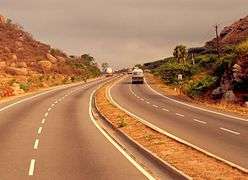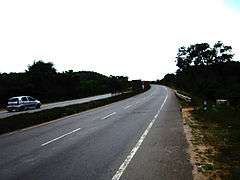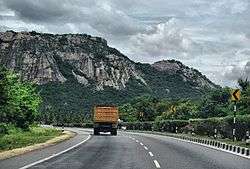Golden Quadrilateral
The Golden Quadrilateral (GQ) is a national highway network connecting most of the major industrial, agricultural and cultural centres of India. It forms a quadrilateral connecting the four major metro cities of India, viz., Delhi (north), Kolkata (east), Mumbai (west) and Chennai (south). Other cities connected by this network include Ahmedabad, Bengaluru, Balasore, Bhubaneswar, Cuttack, Durgapur, Jaipur, Kanpur, Pune, Kolhapur, Surat, Vijayawada, Ajmer, Vizag, Bodhgaya, Varanasi, Agra, Mathura, Dhanbad, Gandhinagar, Udaipur, and Vadodara. The main objective of these super highways is to reduce the distance and time between the four mega cities of India.
| Golden Quadrilateral स्वर्णिम चतुर्भुज | |
|---|---|
 Highway map of India with the Golden Quadrilateral highlighted in solid blue colour | |
| Route information | |
| Maintained by NHAI | |
| Length | 5,846 km (3,633 mi) |
| Delhi – Kolkata | |
| Length | 1,453 km (903 mi) |
| Major junctions | NH 19 |
| Delhi – Mumbai | |
| Length | 1,419 km (882 mi) |
| Major junctions | NH 48 |
| Mumbai – Chennai | |
| Length | 1,290 km (800 mi) |
| Major junctions | NH 48 |
| Chennai – Kolkata | |
| Length | 1,684 km (1,046 mi) |
| Major junctions | NH 16 |
| Highway system | |



_at_Visakhapatnam.jpg)


At 5,846 kilometres (3,633 mi), it is the largest highway project in India and the fifth longest in the world.[1] It is the first phase of the National Highways Development Project (NHDP), and consists of four- and six-lane express highways, built at a cost of ₹600 billion (US$8.4 billion).[2] The project was planned by 1999, launched in 2001, and was completed in 2012.[3]
The Golden Quadrilateral project is managed by the National Highways Authority of India (NHAI) under the Ministry of Road, Transport and Highways. The vast majority of the system is not access controlled, although safety features such as guardrails, shoulders, and high-visibility signs are in use. The Mumbai–Pune Expressway, the first controlled-access toll road to be built in India, is a part of the GQ Project but not funded by NHAI, and is separate from the main highway. Infrastructure Leasing & Financial Services (IL&FS) has been one of the major contributors to the infrastructural development activity in the GQ project.
History and costs
The Golden Quadrilateral Project (GQ Project) was intended to establish faster transport networks between major cities and ports, provide smaller towns better access to markets, reduce agricultural spoilage in transport, drive economical growth, and promote truck transport.
Prime Minister Atal Bihari Vajpayee laid the foundation stone for the project on 6 January 1999.[4] It was planned to be completed by 2006, but there were delays due to land acquisition constraints and disputes with contractors which had to be renegotiated.[5][6]
India's government had initially estimated that the Golden Quadrilateral project would cost ₹600 billion (US$8.4 billion) at 1999 prices. However, the highway was built under-budget. As of August 2011, the cost incurred by the Indian government was about half of the initial estimate, at ₹308.58 billion (US$4.3 billion). The eight contracts in progress, as of August 2011, were worth ₹16.34 billion (US$230 million).[7]
In January 2012, India announced the four-lane GQ highway network as complete.[8][9] In September 2009, it was announced that the existing four-laned highways would be converted into six-lane highways.[10] Sections of NH 2, NH 5 and NH 8 were prioritized for widening to six lanes under DBFO (Design, Build, Finance, Operate) pattern and more sections would be six-laned in the future. On NH 8 six-lane work was completed from Vadodara to Surat.
| No. | Segment | Length | Completed | Source[11][12] |
|---|---|---|---|---|
| 1. | Delhi–Kolkata | 1,453 km (903 mi) | 31 August 2011 | |
| 2. | Chennai–Mumbai | 1,290 km (800 mi) | 31 August 2011 | |
| 3. | Kolkata–Chennai | 1,684 km (1,046 mi) | 31 May 2013 | |
| 4. | Mumbai–Delhi | 1,419 km (882 mi) | 31 August 2011 | |
| Total | 5,846 km (3,633 mi) | 31 May 2013 |
Route
Only National Highways are used in the Golden Quadrilateral. The four legs use the following National Highways (new numbering system):

Connected cities
| Delhi–Kolkata | Kolkata–Chennai | Chennai–Mumbai | Mumbai–Delhi |
|---|---|---|---|
Length in each state
The completed Golden Quadrilateral passes through 12 states and a Union territory:
- Andhra Pradesh – 1,014 km (630 mi)
- Uttar Pradesh – 756 km (470 mi)
- Rajasthan – 725 km (450 mi)
- Karnataka – 623 km (387 mi)
- Maharashtra – 487 km (303 mi)
- Gujarat – 485 km (301 mi)
- Odisha – 440 km (270 mi)
- West Bengal – 406 km (252 mi)
- Tamil Nadu – 342 km (213 mi)
- Bihar – 204 km (127 mi)
- Jharkhand – 192 km (119 mi)
- Haryana – 152 km (94 mi)
- Delhi – 25 km (16 mi)
- Total – 5,846 km (3,633 mi)
Corruption allegations
In August 2003, Jharkhand-based project director Satyendra Dubey, in a letter to the prime minister, outlined a list of bad faith (mala fide) actions in a segment of a highway in Bihar. Dubey's claims included that big contractors had inside information from NHAI officials,[13] that the contractors for this stretch were not executing the project themselves (as stipulated in the contract) but had subcontracting the work to small builders who lacked technical expertise,[13] and that no follow-up was performed after awarding advances.[13] Dubey's name was leaked by the prime minister's office to the NHAI,[13] and he was transferred against his wishes to Gaya, Bihar, where he was murdered on 27 November.[13]
The NHAI eventually admitted that Dubey's allegations were substantiated, and implemented "radical reforms" in the selection and contract procedures.[14] After considerable Central Bureau of Investigation scrutiny, Mantu Kumar and three accomplices were arrested and charged with murder. Mantu escaped from court on 19 September 2005,[15] but was recaptured a month later. In 2010, Mantu and two others were convicted of murder and other offenses and sentenced to life in prison.[16]
See also
- Diamond Quadrilateral
- List of National Highways in India by highway number
- List of National Highways in India
- National Highways Development Project
- North-South and East-West Corridor
- Transport in India
- Bharatmala
References
- "Archived copy". Archived from the original on 14 April 2015. Retrieved 2013-07-23.CS1 maint: archived copy as title (link) Road network-Source-The National Highways Authority of India (NHAI)
- Golden Quadrilateral Highway Network. Road Traffic Technology (2011-06-15). Retrieved on 2013-12-06.
- "Building India's National Pride: The Golden Quadrilateral".
- "Golden Quadrilateral still has miles to go". Financial Express.
- R. N. Bhaskar. "Crossing the chasm". Forbes India.
- "Contractors take the sheen off Golden Quadrilateral". The Financial Express. 3 August 2011. Archived from the original on 31 July 2012.
- "Govt declares Golden Quadrilateral complete". The Indian Express. 7 January 2012.
- "National Highways Development Project Map". National Highways Institute of India. Archived from the original on 4 March 2016. Retrieved 5 December 2005.
- Megha Bahree (21 September 2009). "Ambassador: Indian Economy Will Grow". Forbes.
- Govt. of India declares "Golden Quadrilateral" complete - Jan 7th 2012
- NHAI - Current status
- Bihar govt wakes up to IITian's murder-Source-Rediff News
- NHAI report to CBI proves Dubey right, contract rules being rewritten-Source-Indian Express
- Whistleblower in the 2004 National Highway Authority of India case escaped from police custody on Tuesday in Patna-Source-Rediff News
- Satyendranath Dubey killers get life imprisonment-Source-Oneindia. com
- Fast Lane to the Future, Don Belt. National Geographic, October, 2008.
External links
- 'Mile by Mile, India Paves a Smoother Future' – extremely detailed New York Times article, dated 4 December 2005 (free registration required)
- "Golden Quadrilateral still has miles to go" – Financial Express article dated 26 August 2005
- Official website of the National Highways Authority of India
- Map of GQ progress on the NHAI website
- Ministry of Road Transport


